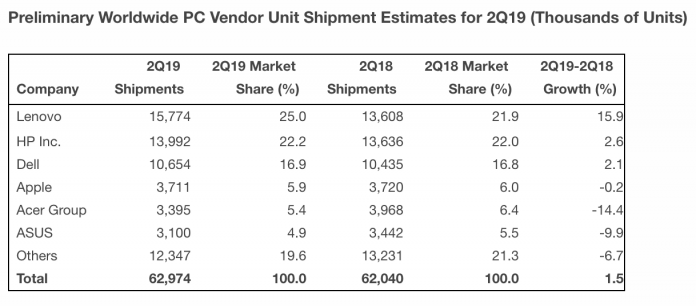After two quarters of decline, the worldwide PC market grew 1.5% in the second quarter of 2019, says Gartner. Shipments totaled 63 million units in the second quarter of 2019, up from 62 million units in the second quarter of 2018.
“Worldwide PC shipments growth was driven by demand from the Windows 10 refresh in the business market in the second quarter of 2019. Desktop PC growth was strong, which offset a decline in mobile PC shipments,” said Mikako Kitagawa, senior principal analyst at Gartner.
“Additionally, there are signs that the Intel CPU shortage is easing, which has been an ongoing impact to the market for the past 18 months. The shortage mainly impacted small and midsize vendors as large vendors took advantage and continued to grow, taking market share away from the smaller vendors that struggled to secure CPUs.”
The ongoing trade dispute – and potential imposition of tariffs – adds uncertainty to the near-term outlook for PC demand.
“While the U.S.-China trade war did not impact the PC market in the second quarter of 2019, the next phase of tariffs could have significant impact. Most laptops and tablets are currently manufactured in China and sales of these devices in the U.S. could face significant price increases if the punitive tariffs are imposed and vendors do not take quick action to respond,” said Ms. Kitagawa.
The top three vendors – Lenovo, HP, and Dell – accounted for 64.1% of global PC shipments in the second quarter of 2019, compared with 60.7% of shipments in the second quarter of 2018. These top three vendors continued to gain share in the PC market taking advantage of economies of scale. Intel’s CPU supply shortage in the first half of the year accelerated this trend, says IDC.
Lenovo retained the top spot in the second quarter of 2019 with the fastest year-over-year growth and the largest share gain among the top vendors. However, it is possible that its shipments reflected some anticipation of the potential tariffs. Lenovo experienced double-digit shipment growth in all key regions except Latin America, where the overall PC market declined.
HP’s worldwide PC shipments increased 2.6% in the second quarter of 2019 versus the same period last year. Strong business PC demand boosted HP Inc.’s growth across all key regions and offset weaker mobile PC shipments. Gartner does not include Chromebooks in the PC market, but HP experienced strong growth in Chromebooks shipments and will most likely remain the leader in the segment.
Dell recorded its sixth consecutive quarter of PC shipment growth in the second quarter of 2019. Dell’s growth trend has been the most consistent out of the top vendors over the past three years, driven by its clear focus on where the company invests.
Regional overview
In the U.S., PC shipments totaled 14 million units in the second quarter of 2019, a 0.4% decline from the second quarter of 2018. HP retained the top spot in the U.S. based on shipments, as its market share increased to 29.8%. Dell remained in the No. 2 position with 28.4% market share.
The EMEA PC market returned to growth in the second quarter of 2019 with a 1.7% increase year over year. Business demand remained strong, as companies and government organizations continued with Windows 10 deployments and a refresh of their PC installed base, but consumer demand remained very weak, as many mainstream users are not seeing enough innovation outside of gaming and high-end mobile PCs. This continues to result in longer PC life cycles and has a very negative impact on mid-tier PC vendors that sell more to the consumer segment.
PC shipments in Asia/Pacific declined 1% compared with a year ago, the third consecutive quarter of shipment decline for the region. A large part of the decline can be attributed to a weak China market as overall sentiment was to tighten spending due to uncertainties. Other Asia/Pacific markets showed better results as Windows 10 migration drove growth in mature countries such as Australia and New Zealand. Business PC demand also drove strong growth for Japan in the second quarter of 2019.
Latin America PC shipments experienced a 3.9% decline in the second quarter of 2019, which was modest compared with the previous two quarters. The market was affected by economic and political uncertainties as well as the CPU shortage. Emerging regions such as Latin America tend to have lower priority for CPU allocation, so the impact from the shortage could be larger than in other mature regions.
[Image courtesy: Gartner]
